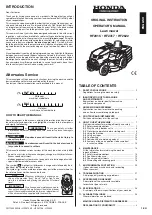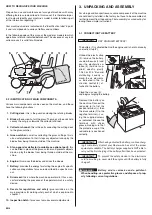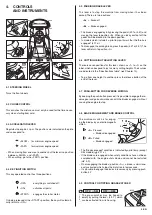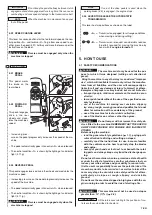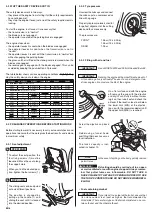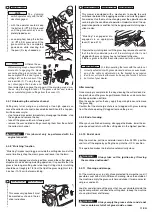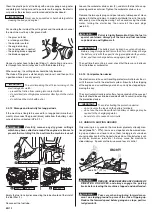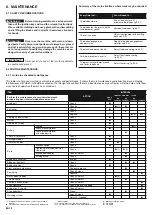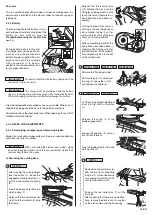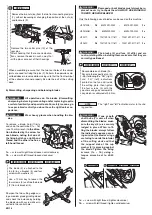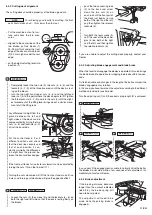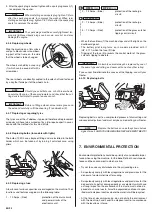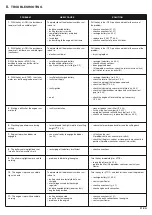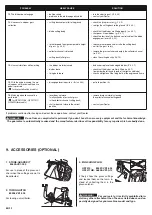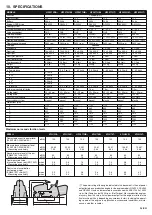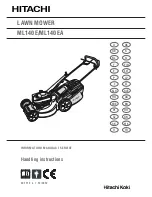
5.2 WHY THE SAFETY DEVICES CUT IN
The safety devices work in two ways:
– they prevent the engine from starting if all the safety requirements
have not been met;
– they stop the engine if even just one of the safety requirements is
lacking.
To start the engine, in all cases it is necessary that:
– the transmission is in “neutral”;
– the blades are not engaged;
– the operator is seated or the parking brake is engaged.
The engine stops when:
– the operator leaves his seat when the blades are engaged;
– the operator leaves his seat when the transmission is not in
“neutral”;
– the operator leaves his seat with the transmission in “neutral” but
without engaging the parking brake;
– the grass-catcher is lifted or the stone-guard is removed when the
blades are engaged;
– the reverse gear is engaged with the blades engaged.This can be
avoided by keeping the push-button 4.7 pressed.
The table below shows various operating conditions,
highlighting
why the safety device shuts down the engine.
5.3 PRELIMINARY OPERATIONS BEFORE STARTING WORK
Before starting to work it is necessary to carry out several checks and
operations to ensure that the work gives the best results and is done
in maximum safety.
5.3.1 Seat adjustment
To adjust the seat position, the
four fixing screws (1) must be
loosened. Move the seat along
the support slots.
When you find the desired posi-
tion, tighten the four screws (1).
The sliding seat can be adjusted
onto six different positions.
The position is changed by
pulling up the handle (1) and
sliding the seat until it is locked
into the desired position.
HF2•••H
♦
•
HF2315SB•
5.3.2 Tyre pressure
Unscrew the hubcaps and connect
the valve caps to a compressed air
line with a gauge.
Proper tyre pressure levels arevital
for perfect alignment of the cutting
deck and thus mows evenly.
The pressures are:
FRONT
1.5 bar (13 x 5.00-6)
1.0 bar (15 x 5.00-6)
REAR
1.2 bar
5.3.3 Filling with oil and fuel
Use oil SAE 10W30 and Petrol Unleaded Euro 95.
Running the engine with an insufficient amount of
oil can damage it very seriously.The use of a non-detergent or two-
stroke engine oil can reduce the life of the engine.
On a flat surface and with the engine
off, remove the cap with the dipstick
and dry it.Push it fully in without screw-
ing it on, then take it out and check the
oil level. If the level is close to or below
the lower limit (MIN) of the dipstick,
top up with the recommended oil until
the upper limit (MAX) is reached.
Screw the dipstick cap back
on.
Refuel using a funnel. Avoid
overfilling;filler neck has a max
level indication.
The tank's capacity is indi-
cated in chapter 10.
In the event of spilling on the body, quickly remove
petrol traces.
Refuelling should be carried out in an open
or well ventilated area with engine stopped. Always remem-
ber that petrol fumes are inflammable. DO NOT TAKE A
NAKED FLAME TO THE TANK’S OPENING IN ORDER TO SEE
THE TANK’S CONTENTS AND DO NOT SMOKE WHEN REFU-
ELLING.
•
Fuel containing alcohol
If you intend to use fuel with alcohol, ensure that
its octane number is at least as high as that recommended by
Honda (86).There are two types of fuel/alcohol mixtures: one con-
tains ethanol and the other methanol.
IMPORTANT
DANGER!
NOTE
IMPORTANT
IMPORTANT
8
EN
OPERATOR
GR.-CATCHER
BLADES
TRANSMISSION
BRAKE
ENGINE
A) PILOT LAMPS ON
(Key in «ON» position)
Sitting
YES
Disengaged
«N»
Engaged
Stopped
Sitting
NO
Disengaged
«N»
Disengaged
Stopped
B) WHEN STARTING
(Key in «START» position)
Sitting
–/–
Disengaged
1...5 - F / R
Engaged
Does NOT start
Sitting
–/–
Engaged
«N»
Engaged
Does NOT start
Absent
–/–
Disengaged
«N»
Disengaged
Does NOT start
C) WHEN MOVING
(Key in «ON» position)
Sitting
YES
Disengaged
1...5 - F / R
Engaged
Stops
Absent
YES
Disengaged
«N»
Disengaged
Stops
D) WHEN CUTTING GRASS
(Key in «ON» position)
Sitting
NO
Engaged
–/–
Disengaged
Stops
Sitting
YES
Engaged
R
Disengaged
Stops *
Absent
YES
Disengaged
«N»
Disengaged
Stops
Absent
YES
Engaged
–/–
Engaged
Stops
* This may be avoided by keeping the push-button 4.7 pressed

